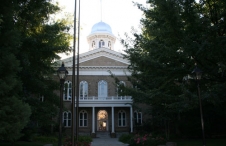Americans at the Birth of Nevada
Historians of ethnicity and immigration often overlook those born in the United States, and yet these people have just as much sense of a self-identity as someone from another country. Between 1850 and 1860, virtually everyone in the western Great Basin except the Paiute, Shoshone, and Washoe Indians came from somewhere else, and the newly-arrived brought distinct, diverse experiences and prejudices.
Of the people who settled in the state, American-born Nevadans have always been in the majority, even though Nevada had more foreign-born than most states in the nation for its first several decades. This large amount of foreign-born residents shaped the character of the newly forming society. It also affected the experience of native-born Americans who settled in the western Great Basin. By founding ethnic businesses and speaking many languages on the street, and by filling the calendar with celebrations from dozens of homelands, the diverse population gave the state a cosmopolitan, international feel. While the significance of foreigners is clear, the numerical importance of Nevadans from the United States should never be overlooked. Of course, every American-born Nevadan could also claim an ethnicity, further complicating the story of self-perception. In addition, there were times when American-born residents were in the minority in certain communities.
Beginning in 1859, the western Great Basin experienced a population explosion following the discovery of the Comstock Lode and the subsequent rush to Washoe. Federal enumerators for the 8th U. S. Census in 1860 documented a population in the western part of Utah territory that was almost one-third foreign-born. Local enumerators generally failed to record American Indians, who were an ever-present part of the region. Of the 6,853 people recorded in the western Great Basin, slightly more then two-thirds, or 4,731, came from the United States or its territories. Nearly half were from the Northeast, which sent 44 percent of the region's Americans. The South, standing on the brink of Civil War, contributed only 21 percent of the native-born population to the future Nevada territory.
Native Midwesterners represented 29 percent of the Americans in the future Nevada, but the 1860 census indicates that many from west of the Mississippi had parents born elsewhere, and they had merely stopped in the Midwest long enough to have a few children before moving on. Similarly, those with western nativity, nearly 7 percent of the Americans, were almost all children, underscoring the youth of a society where most adults were from somewhere else.
Settlers from the Northeast and Midwest represented nearly three-quarters of the Americans, profoundly affecting Nevada politics. The predominance of northerners helped make Nevada a fiercely pro-Union territory, created less than a year after the 1860 census, and this inspired President Abraham Lincoln to push for Nevada statehood before the election of 1864 in the midst of the Civil War.
An additional difference between those from the Northeast and South involves gender. Of the 4,731 native-born Americans in the future Nevada territory in 1860, only 579 or 12 percent were females, and many of these were children from the West or Midwest. Most women from the United States and its territories came from the East, but 10 percent of the southerners were women compared to the Northeast's 7 percent. As a point of comparison, speakers of Spanish and immigrants from Britain and Ireland in 1860 also contributed more women per capita than the states of the Northeast. Of course, the vast majority of the newly-arrived from any region were single men in search of opportunity and adventure. The scarcity of women affected western Great Basin demography for decades beginning in the 1850s.
The 1870 census documents a changing Nevada population. The native-born had lost ground, representing only a slight majority at roughly 56 percent. Relative distances gave the native-born an advantage in the first months of the 1859 rush to Washoe following the discovery of the Comstock Lode. Foreigners made up for a slow start by arriving in ever-increasing numbers throughout the rest of the decade, but they never became the majority.
Article Locations
Related Articles
Further Reading
None at this time.


